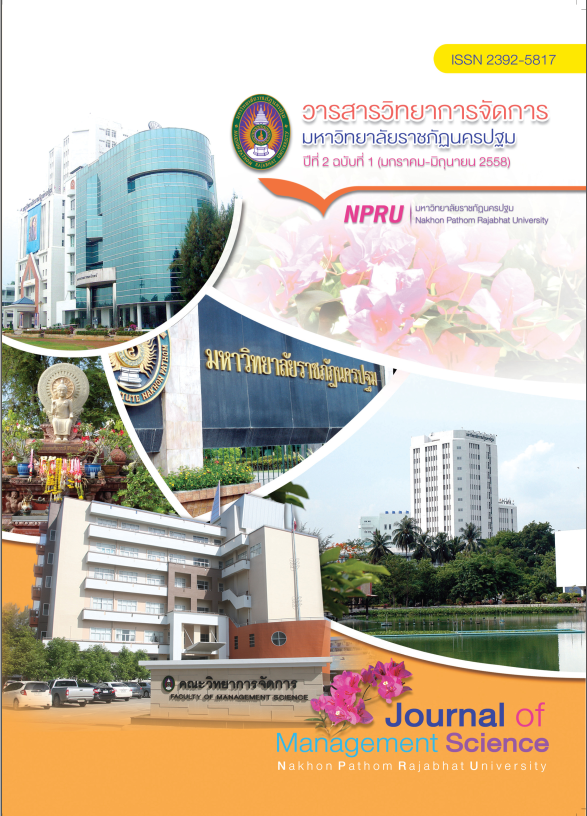The development of marketing strategies to create perceived value thai dessert in Samusakhon province, the creative economy concept.
Main Article Content
Abstract
The objective of the study were to 1) to study consumer behavior of thai dessert, the marketing in buying thai dessert and the perceived value of the consumers in Samutsakhon province 2) to compare for perceived value of thai dessert consumers in Samutsakhon province divided to the personal factors 3) to study the factors that affect to the perceived value of the consumers in Samutsakhon province 4) to develop a marketing strategy to create perceived value thai dessert in Samusakhon province, the creative economy concept. The samples of the research are 400 thai dessert consumers in Samutsakhon province. The samples are selected dy multi-stage sampling and 9 key informants of focus group discussion, statistical analysis consisted of frequency, percentage, arithmetic mean, standard deviation, t-test, one-way analysis of variance, stepwise multiple regression analysis and content analysis.
The results of the study were follows as 1) the thai dessert behavior of consumer in samutsakhon found that the reason to select thai dessert are 167 consumers, 41.8 % the decision to buy thai dessert is the most of decision to buy thai dessert is themselves. There are 250 peoples, 62.5 % the most of expense to buy thai dessert is paid below 100 there are 128 peoples, 32.0 % The most of quantity of buying thai dessert per a month is twice. There are 139, 34.7 % the most of places to buy thai dessert are at the market. There are 190, 47.5 %, the most of data that use decision to buy is baker there are 162, 40.5 %. The most type of thai dessert that popular is syrup. there are 206, 51.5 % 2) the thai dessert marketing mixes of the samples found that product, price, place and promotion, are high proficiency 3) the samples of the research are gender, age, education level, occupation and income are the perceived value thai dessert not different statistically significant 4) the factors that affect the perceived value of thai dessert, creative economy concept found that product price and promotion can affective to perceive value of thai dessert, creative economy concept is 56,70 percentage 5) the development strategy for recognition of the valve of qualitative in Samutsakhon province found that product should different ingredient, taste, packaging and apply with international dessert. The pricing base on product cost. The channel learning center with retail shop. promotion online advertising thai dessert decoration with cartoon.
Article history : Accepted 6 May 2015
SIMILARITY INDEX = 0.00
Article Details
The views and opinions of the article appearing in this journal are those of the author. It is not considered a view and responsibility of the editorial staff.
References
จักรพล ตั้งสุทธิธรรม. (2554). การศึกษาความเป็นไปได้ในการจัดตั้งและบทบาทของศูนย์เศรษฐกิจสร้างสรรค์ในเทศบาลตำบลสุเทพ อำเภอเมืองเชียงใหม่ จังหวัดเชียงใหม่. เชียงใหม่. มหาวิทยาลัยเชียงใหม่.
ธีรศักดิ์ อุ่นอารมณ์เลิศ. (2549). เครื่องมือวิจัยทางการศึกษา : การสร้างและการพัฒนา. นครปฐม : มหาวิทยาลัยศิลปากร.
ปฏิพล ตั้งจักรวรานนท์. (2549). คัมภีร์นักการตลาด. กรุงเทพฯ : ธรรมกมลการพิมพ์.
พรรณิภา เจริญสุข. (2549). บทบาทของคุณค่าตราสินค้าที่มีความสัมพันธ์กับพฤติกรรมของผู้บริโภคในเขตกรุงเทพมหานครของร้านกาแฟสตาร์บัคส์ และบ้านไร่กาแฟ. ปริญญาบริหารธุรกิจมหาบัณฑิต สาขาวิชาการตลาด มหาวิทยาลัยศรีนครินทรวิโรฒ.
พัทธนันท์ พิทาคำ. (2554). พฤติกรรมการซื้อขนมไทยของผู้บริโภคในอำเภอเชียงใหม่. ปริญญาบริหารธุรกิจมหาบัณฑิต มหาวิทยาลัยเชียงใหม่.
มรกต กำแพงเพชร. (2552-2553, ธันวาคม-พฤษภาคม). ผู้ประกอบการไทยในยุคเศรษฐกิจสร้างสรรค์. วารสารมหาวิทยาลัยฟาร์ อีสเทอร์น, ปีที่ 3 (ฉบับที่ 2), 52.
วิชุดา ดิษบรรจง ศิริขวัญ กำเนิดจอก วชิรพงษ์ สมภาร บนนยง บุญมี จันทนา สุวรรณ ตรัยศักดิ์ วิเศษณ์ศรี ตรีเนตร พรหมมา และเตือนจิต เครือใย. (2548). รายงานการวิจัยเรื่อง ปัจจัยทางการตลาดที่มีผลต่อการซื้อขนมไทย ของผู้บริโภคในกรุงเทพมหานคร. กรุงเทพฯ : มหาวิทยาลัยราชภัฏจันทรเกษม.
ศิริวรรณ เสรีรัตน์ และคณะ. (2550). กลยุทธ์การตลาดและการบริหารเชิงกลยุทธ์โดยมุ่งที่ตลาด. กรุงเทพฯ : ธนธัชการพิมพ์.
สุรพงษ์ สืบวงศ์ลี. (2551). สร้างเศรษฐกิจไทยด้วยความคิดสร้างสรรค์. กรุงเทพฯ : ดับเบิ้ลยูพริ้นท์ จำกัด
สำนักงานคณะกรรมการพัฒนาการเศรษฐกิจและสังคมแห่งชาติ. (2554). แผนพัฒนาเศรษฐกิจและสังคมแห่งชาติ ฉบับที่ 11 (พ.ศ. 2555-2559). กรุงเทพฯ: สำนักนายกรัฐมนตรี.
สุนิสา ส่งศิริพันธ์. (2555). ทัศนคติและพฤติกรรมการบริโภคที่มีผลต่อการตัดสินใจซื้อขนมไทยของ ผู้บริโภค ในจังหวัดพระนครศรีอยุธยา. ปริญญาบริหารธุรกิจมหาบัณฑิต มหาวิทยาลัยราชภัฏพระนครศรีอยุธยา.
อรทัย เลิศวรรณวิทย์. (2556). รายงานการวิจัยเรื่อง แนวทางการสร้างและจัดการอัตลักษณ์สำหรับขนมไทย เพื่อส่งเสริมการท่องเที่ยวเชิงวัฒนธรรม. กรุงเทพฯ : มหาวิทยาลัยราชภัฏสวนดุสิต.
Aaker, David. (1991). Managing Brand Equity : Capitalizing on the Value of Brang Name. 1st ed. New York : Free Press.
Cochran, W.G. (1997). Sample Techniques. 3rd ed. New York : John Wiley and Sons Inc.
Kotler, Philip. (2000). Marketing Management, The Millennium Edition. New Jersey : Prentice Hall.


